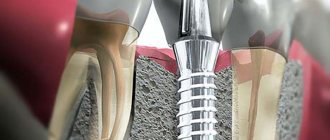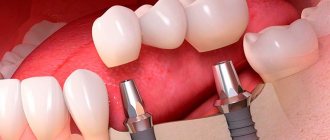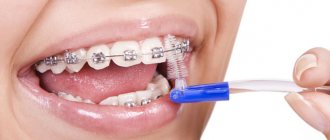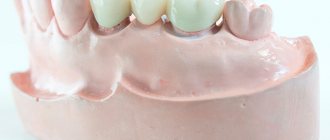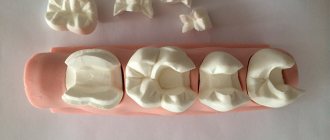The process of dental implantation is associated with a surgical intervention in the human body, during which an implant (a titanium pin simulating a tooth root) is installed in the jawbone, and then a crown is fixed to it.
Although implantation is not new as an effective and safe way to restore lost teeth using artificial roots, some people still consider it a painful procedure and prefer classic prosthetic solutions. Is dental implantation really painful? Let's try to understand this issue.
Dental pin: what is it, its advantages and disadvantages
What is a dental post? This is a specialized dental structure that looks like a rod. It is installed into the tooth root as a support for a filling or crown. Installation of a pin is only possible if the tooth has a healthy root. As a rule, this design is used if the tooth is badly damaged and thin walls remain.
Advantages:
- reducing the load on the tooth root;
- the ability to restore the crown in just one visit to the dentist;
- ease of installation;
- high level of aesthetics of the future artificial tooth;
- relatively low cost.
Flaws:
- instability under heavy chewing loads;
- there is a risk of damage to the root walls;
- allergic reactions and the development of secondary caries are possible;
- metal rods can only be removed together with the tooth.
To successfully install the pin, the following conditions will need to be met:
- the length of the rod must be at least 2/3 of the length of the dental canal;
- the size of the rim of healthy tooth tissue is at least 2 mm;
- root canal treatment was carried out with high quality;
- the root canal was given a cylindrical or conical shape.
How to install the pin? Does it hurt?
If you have entrusted dental treatment or prosthetics to a doctor from a clinic with a good reputation, there is no need to worry. We are sure that you will not experience any unpleasant sensations. First, the doctor will examine the tooth, decide on the use of a pin, and tell you how the installation will proceed.
If the root canal is filled, it will need to be unfilled to place the pin. This is followed by direct installation and fastening of the pin with a composite material.
Once the material has hardened and the pin is securely fastened, the doctor can begin restoring the shape of the tooth. If a pin is used on a front tooth, you should pay special attention to the restoration so that the shades of the restored tooth and the “neighbors” located next to it match, and the artificial tooth does not stand out from the series due to color.
How long does it take to install a pin and how painful is this process?
The duration of the procedure directly depends on the initial condition of the oral cavity. If there are no problems, the pin is placed in one visit to the dentist. If periodontal diseases and other pathologies are present, a pin will be installed in the tooth root only after they have been eliminated.
Since the doctor touches soft tissue during the implantation of the supporting element, the procedure is often accompanied by painful sensations. The occurrence of pain after nerve removal is a natural process. But if a long-depulped tooth hurts, it is possible that the rod has entered too deeply into the canal. X-rays will help identify the cause of the pain.
How to Reduce or Prevent Pain During Recovery, Do's and Don'ts
In the postoperative period, the main thing is to strictly follow all the doctor’s recommendations. Basic:
- in the first hours after implantation, do not eat or drink;
- the first days (about a week) eat liquid foods: soups, purees, baby food;
- exclude hot, cold, spicy, alcohol;
- After surgery, apply cold compresses to relieve swelling;
- take prescribed medications strictly according to the schedule. Do not cancel them yourself if you feel better;
- make mouth baths using antiseptics: chlorhexidine, chamomile;
- sleep on a high pillow and on the opposite operating side;
- forget about physical activity for a while;
- Going to bathhouses and saunas is prohibited.
Usually, every dental clinic has a reminder about what is possible after implantation, what is prohibited, how to relieve pain after dental implantation, and a schedule for visiting the doctor.
The doctor will definitely prescribe painkillers - Nurofen, Nimesil, Analgin, Nise, etc. They need to be taken as long as the pain lasts after installing the dental implant, up to 7-10 days. If it persists longer, it is better to contact your dentist.
Indications and contraindications for installing pins
Indications:
- damage to the tooth crown by more than 50%;
- the need to create support for prostheses;
- tooth loss;
- weakening of the tooth due to dental diseases.
Contraindications:
- untreated caries;
- the presence of inflammatory processes in the area of the tooth root;
- root destruction;
- blood diseases;
- insufficient thickness of the root canal;
- the presence of caries and periodontal inflammation;
- granulomas, cysts;
- exacerbation of systemic diseases;
- pregnancy;
- allergy.
It is important to know. The choice of the most suitable type of pin is always up to the doctor. It is unacceptable to focus only on the cost of the dental structure.
Recommendations after surgery
Most often, implant rejection occurs due to the patient’s fault (failure to follow the dentist’s recommendations, failure to go to the clinic in a timely manner in case of complications, self-medication).
In order for the implant to take root, you need to follow a number of simple recommendations:
- Do not eat for 2 hours;
- During the entire healing period, do not eat spicy or too hard foods, avoid cold or hot foods;
- You can only chew on the side of the jaw opposite the sutures (to avoid their divergence);
- Take anti-inflammatory and painkillers recommended by your doctor, do antiseptic baths and rinses.
- Daily regular oral hygiene (brushing and paste, rinsing, flossing, etc.);
- If swelling occurs, apply ice to the cheek;
- Avoid any types of serious physical activity, avoid overwork;
- Smoking and drinking alcohol are ideally allowed only 1-2 weeks after surgery;
- Avoid active articulation, sneeze and cough very carefully;
- Add as many vitamins, minerals and nutrients to your diet as possible.
If these simple recommendations are followed, implant rejection, as well as the occurrence of any other serious complications, are excluded.
To avoid problems during implantation surgery, as well as in the postoperative period, you should give preference to trusted clinics and experienced, highly qualified specialists.
Pin Installation Procedure
How to install a pin in a tooth? The procedure occurs in several stages:
- Removal of all dental tissues affected by caries.
- Preparing the bed for the pin using a special reamer and calibration cutter.
- Root canal preparation.
- Fitting the rod to the tooth.
- Installation of the pin; dual-curing adhesive is used as a fixing element.
- Restoration work using a crown or prepared filling material.
The Saint-Dent Clinic in Moscow offers a wide range of dental services for adults and children. The current cost of services can be found here, the contact page is located here.
Is extension on a pin promising?
Of course, it is impossible to call the tooth extension procedure unpromising. This technique is constantly being improved, new technologies are being proposed that impress with their minimal trauma and safety for the patient. This relatively new practice is the installation of fiberglass pins.
Design of fiberglass pins "Rebilda Post" and pins from Russian manufacturers
Creating the final root canal configuration using a calibration drill
Calibration drill versus reamer
After processing the channel with a calibration drill
Silanization of the pin
Application of Futurabond DC adhesive using microbrushes
Restoration of the crown part of the tooth
Fiberglass pins are distinguished by their special plasticity, and this is really important, because the process of splitting the tooth root must be prevented, and the elasticity of the tooth contributes to this. Most often, fiberglass pins are installed in chewing teeth, since they bear the main, cantilever loads during food intake.
RelyX™ Fiber Post
The patient has the right to find out which pin will be installed, what determines the doctor’s choice, and how the extension procedure will take place. The doctor warns the patient about possible complications and talks about what needs to be done to prevent these complications from occurring.
Successful treatment!
Possible complications
- severe pain, swelling;
- root fracture;
- restoration chips;
- the occurrence of a local allergic reaction to the material from which the rod is made;
- development of the inflammatory process (stomatitis, periodontitis);
- cyst development;
- fistula formation;
- mechanical damage to the walls of the tooth, which can lead to perforation of the root canals;
- splinters from dental instruments getting into the root canal.
It is important to know. The most dangerous complication is rejection of the installed supporting element by the body. In this case, it must be completely removed from the oral cavity.
Does pain occur after the anesthesia wears off?
When patients receive a negative answer to the question of whether it is painful to insert an implant, they usually ask the following. It goes like this: “How will I feel after the anesthetic wears off?” Since implantation is a surgical intervention that is associated with tissue trauma, the body reacts to it. Normally after surgery the following occurs:
- pain of varying intensity;
- swelling of the gums and cheeks on the corresponding side of the face and jaw;
- itching, feeling of tissue compression in the area of the operation.
Dentistry also copes with such phenomena. To do this, the doctor prescribes the patient a course of painkillers, anti-inflammatory, and antibacterial drugs. If there are no complications, the prescribed medications are sufficient to eliminate severe pain. To avoid unwanted reactions of the body, you should not touch the wound with your tongue, take a hot bath, drink alcohol, or violate other recommendations of your doctor.
What to do if a tooth with a pin hurts
In the first hours, rinsing the mouth with a soda solution (1 teaspoon of soda per glass of water) will help relieve toothache. A decoction of chamomile and sage has a similar effect. You can also take painkillers and apply ice to your cheek in the area where the pin was placed.
It is important to know. The occurrence of slight swelling and pain in the first days after installation of the pin is normal. But if these symptoms persist for a long time and the patient experiences an elevated body temperature, you should consult a dentist.
Are there any contraindications for pin prosthetics technology?
Yes, like any serious medical procedure, this one also has a number of contraindications. First of all, they are related to the condition of the patient’s gums: periodontitis, as well as all kinds of granulomas and cysts.
Those who know about the presence of allergic reactions in their body should be especially careful when installing pins. Since the pin will be in contact with your tissues, it will be better if you are firmly confident that you are not allergic to its material.
The most common questions about pins and answers to them
Is it always possible to get by with a pin?
Unfortunately no. In case of significant tooth decay, when there is a risk of further destruction of the coronal part, dental prosthetics are recommended.
How to care for your teeth after having a pin installed?
For two weeks, it is not advisable to eat too hard food and use toothpicks. When brushing your teeth, you need to be as careful as possible so as not to injure your gums.
Is there an alternative to a dental post?
Yes, you can install a stump tab instead. This is a microprosthesis, the lower part of which is fixed into the root canals, and the upper part serves as a supporting element for an artificial crown.
Choosing a teeth extension technique
You can choose the optimal method of tooth extension only after consulting a dentist. The doctor will assess the degree of destruction of the dental unit, check the safety of the root and nerve, and depending on this, recommend a suitable method of restoration.
For example, veneers or lumineers are most often used to restore minor damage to incisors and canines. They hide visual defects, straighten the dentition, and return lost whiteness to the unit.
If the hard tissues of the tooth are seriously damaged, then you should resort to crowns or extensions to a pin. In this case, you can completely restore the unit and return it to functionality.
When consulting with a dentist, you need to clarify:
- The service life of the restored tooth, its resistance to wear, food coloring, and the possibility of restoration in the event of a chip. For example, some crowns can be repolished if minor defects appear; reinstallation of the microprosthesis is not required.
- The number of procedures for which it will be possible to grow a tooth. The fastest options are filling and installation of lumineers. Other technologies will require multiple visits to the clinic.
- Tissue healing rate. Some augmentation methods allow you to restore a tooth without damaging the gums. This guarantees the patient minimal discomfort after the procedure.
Different types of extensions differ in price, which must be taken into account when choosing a technique.

